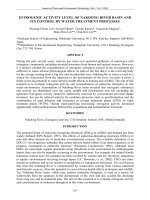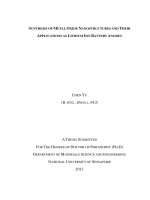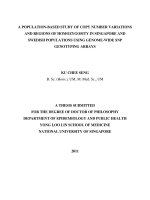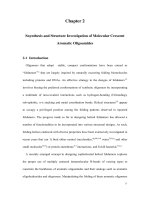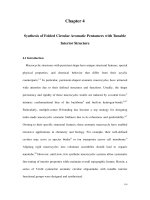Studies on level of infestation of flat headed borer and bark eating caterpillar on Terminalia Arjuna and their management using insecticides
Bạn đang xem bản rút gọn của tài liệu. Xem và tải ngay bản đầy đủ của tài liệu tại đây (178.19 KB, 8 trang )
Int.J.Curr.Microbiol.App.Sci (2019) 8(1): 598-605
International Journal of Current Microbiology and Applied Sciences
ISSN: 2319-7706 Volume 8 Number 01 (2019)
Journal homepage:
Original Research Article
/>
Studies on Level of Infestation of Flat Headed Borer and Bark Eating
Caterpillar on Terminalia arjuna and their Management using Insecticides
Preeti Tirkey1, M. Chandrashekharaiah2*, M.S. Rathore2, R.K. Singh1,
R.B. Sinha2 and Alok Sahay2
1
2
Dr. C.V. Raman University, Kargi Road Kota, Bilaspur, Chhattisgarh, India
Basic Tasar Silkworm Seed Organisation, Central Silk Board, Bilaspur, Chhattisgarh, India
*Corresponding author
ABSTRACT
Keywords
Tasar silkworm,
Flat headed borer,
Bark eating
caterpillar,
Insecticides, Kargi
Kota, Bilaspur
Article Info
Accepted:
07 December 2018
Available Online:
10 January 2019
The Terminalia arjuna is an important deciduous tree species in India and is being utilized
for both medicinal as well as sericulture purposes. The monoculture nature and continuous
use of plantation for rearing of silkworm has profound negative effect on plants vigor,
which attract variety of insect pests. Among them, the borer is very important pests on T.
arjuna, due to their persistence attacking behavior, mainly on weak and young plants.
Among the borer complex, Sphenoptera cupriventris Kerr. (Coleoptera: Buprestidae) and
Indarbela quadrinotatais (Walker) (Lepidoptera: Cossidae) are important pests on T.
arjuna which causes severe damage and reduce plants vigor gradually. Studies were
conducted to evaluate the status of S. cupriventris and I. quadrinotatais on T. arjuna in
around Bilaspur, Chhattisgarh and their management using different insecticides. The S.
cupriventris infestation was significantly more in the block plantation compared to the
natural plantation. Whereas, bark eating caterpillar incidence on T. arjuna was nonsignificant between block and natural plantation. The infestation of S. cupriventris and I.
quadrinotatais on T. arjuna was 51.84 % and 10.41 % at Kargi Kota and 27.19 % and
13.58 % at Bilaspur, respectively. The distribution studies indicated that both the pests
were negative binomial with contiguous distribution in Kargi Kota and Bilaspur. The
insecticide evaluated date indicated that nearly 93.33 % and 90.00 % of plants treated with
chlorpyrifos 20 EC @ 2 ml and deltamethrin 2.8 EC @ 1 ml found free from bark eating
caterpillar damage. Whereas, imidacloprid 17.8 SL@ 0.6 ml/l and 0.4ml/l, dichlorvos 76
EC@ 2.5 ml/l and monocrotophos 36 SL @ 2 ml/l treatments caused cent percent
mortality of grubs in more than 90 % plants.
Introduction
The Terminalia arjuna is an important
deciduous tree belonging to the family
Combretaceae. T. arjuna is distributed in Uttar
Pradesh, southern Bihar, Jharkhand, Odisha,
West Bengal, Chhattisgarh, Madhya Pradesh,
Uttar Pradesh, Deccan region (Telangana,
Maharashtra, Andhra Pradesh, Karnataka,
Kerala and Tamil Nadu) and Burma (Dwivedi,
2007). In India, the T. arjuna is being utilized
for both medicinal purposes as well as
commercial cultivation for tasar silkworm.
The bark extract of T. arjuna is a potential
598
Int.J.Curr.Microbiol.App.Sci (2019) 8(1): 598-605
cardio-protective agent and leaves are used for
rearing of tasar silkworm by the rural and
tribal people in Central India (Jolly et al.,
1974; Dwivedi and Chopra, 2014). Presently,
Government organizations and NGOs are
being involved in the development of
systematic plantation of T. arjuna, in addition
to the rejuvenation of existing forest
plantations for tasar sericulture activity. The
systematic plantations are being used for seed
cocoon production and forest plantations for
commercial cocoon production. The T. arjuna
has been considered as an economically
important crop in India due to its multipurpose
utility in the diversified fields.
In recent years, tasar sericulture is drawing
attention of farming community due to
increasing demand for tasar silk. Since, the
overall demand for tasar silk far exceeds its
production within India (Pastakia, 2015), the
tasar sericulture is considered to be a potential
area in the agriculture sector. For the success
of the tasar culture, three components - feed,
breed and seed are essential, of these, the feed
is the vital component and decides the quality
of the cocoon. The T. arjuna under block
plantation is susceptible for variety of insect
pests. Among them, the borer complex is very
important pests, due to their persistence
attacking behavior, mainly on weak and young
plants. The loss caused in terms of the death of
plants or otherwise, borer damage, which in
turn affect growth and vigor of the plants.
Among the borer complex, the Sphenoptera
cupriventris Kerr. (Coleoptera: Buprestidae)
and Indarbela quadrinotatais (Walker)
(Lepidoptera: Cossidae) are important pests on
T. arjuna and cause severe damage to the
plants and reduce plants vigor gradually. The
round-headed
stem
borer,
Aeolesthes
holosericea Fabr. (Coleoptera: Cerambycidae)
is also an economically important borer on T.
arjuna and their damage led to death of side
branches or the entire plant. The literature
survey indicated that the S. cupriventris and I.
quadrinotatais occurrence in a great extent on
T. arjuna in and around Bilaspur regions
compared to A. holosericea, but with the
scanty information of their infestation level
and management (Prakash et al., 2010; Joshi,
2012).
Both, adults and grubs of S. cuprivenris are
causing damage to T. arjuna plants. The adults
lay eggs by excavating small pits on the bark
and grubs feed on the barks as well as stem by
boring into it. The exit hole made by the adults
also causes damage to the plants. The gum
exudation, bark splitting, rotting and fungus
growth are common symptoms of this pest
damage. Severe damage leads to the death of
plants. Similarly, I. quadrinotatais construct
larval galleries on the stem and feed within the
galleries and bore into the stem and inflict
severe damage to trees and reduce the vigor of
the plant (Dhar et al., 1989; Kumawat and
Swaminathan, 1990; George Mathew, 1997).
The proper identification of susceptible stages
and timely management practices enable the
plants to recover from the pest damage and
maintain the pest population below economic
threshold level.
Majority of the studies follow the manual
killing of borer pests by thrusting of wire or
killing larvae and plugging the hole with mud
after insecticide treatment against bark eating
caterpillar and round headed borer. But, these
methods will not serve the purpose against flat
headed borer and also it is labor intensive to
follow in the large area under block
plantations. Use of chemicals is highly
desirable for management of pests in the block
plantations to ensure quality and vigor.
Different
chemicals
like
permethrin,
carbaryl/sevin,
bifenthrin,
imidacloprid,
chlorpyrifos, DDVP, etc. have been shown
effective against the different borer pests in
different crops (Zahid et al., 2015; Shivankar
and Rao, 2004; Sandhu et al., 1987; Gupta et
al., 2014). The present study is also one such
599
Int.J.Curr.Microbiol.App.Sci (2019) 8(1): 598-605
study intended to examine the severity of bark
eating caterpillar and flat headed borer in and
around Bilaspur region and their management
using different types of newer insecticides.
Materials and Methods
Studies were conducted at Bilaspur and Kargi
Kota regions of Chhattisgarh state. The
Bilaspur is situated in 22.0796° N, 82.1391°
E264 m AMSL. The climate is sub-tropical,
semi-arid and monsoon type. Nearly 2.5 ha
farm with 7000 T. arjuna plants @ 4×4 ft
spacing was selected at Bilaspur. The plants
are 5 years old. Whereas, the Kargi Kota is
located in 22.1022° N, 82.14685° E 330 m
AMSL. The climate is similar to Bilaspur and
about 17.5 ha areas having more than 15,000
T. arjuna plant at 4×4 ft spacing was selected
for the study. A control field with 30 plants
(no silkworm rearing has been conducted) in
the Pendari campus, Bilaspur, which is near to
Bilaspur Farm, was selected for the
comparison.
Samplings were prepared during 2018 for S.
cupriventris and I. quadrinotatais infestation
in both Bilaspur and Kargi Kota farm. For
sampling, the entire area was divided into the
blocks and in each block, infested and healthy
plants were recorded. The percentage and
pattern of infestation was estimated and
analyzed using statistical tools. Similarly, 20
randomly selected plants in the control field as
well as Bilaspur farm were sampled separately
for occurrence of S. cupriventris and I.
quadrinotatais and the data were analyzed
using t-test. To estimate the effect of
infestation of S. cupriventris and I.
quadrinotatais on total branches, a total of 40
each infested with the respective insect-pests
as well as healthy plants were selected in the
Kargi Kota for the observation. The number of
branch per plant in the infested and healthy
plants, was counted and per cent reduction
was estimated.
To study the effectiveness of insecticides
(chlorpyrifos 20 EC @ 0.05 %, 0.1 % and 0.2
%, deltamethrin 2.8 EC @ 0.03 %, 0.06 % and
0.1 %, imidacloprid 17.8 SL @ 0.02 %, 0.04
% and 0.06 %, dichlorvos 76 EC @ 0.075 %,
0.15 %, and 0.25 %, monocrotophos 36SL @
0.05 %, 0.1 % and 0.2 % and azadirachtin
10000 PPM (EC) @ 0.0025 %, 0.005 % and
0.01 %), the S. cupriventris and I.
quadrinotatais infested plants were selected
separately and marked before application of
insecticides.
Insecticides
at
selected
concentration were treated on the selected 10
plants per treatment. Similar procedure was
followed for all the insecticides and ten plants
infested with the respective pests were
selected as a control treatment.
Observations were recorded 30 days after
insecticides treatment. For bark eating
caterpillar, fresh feeding areas on the bark
were considered for the recording activity of
larvae. Whereas, a destructive sampling was
followed for the flat headed borer, in each
treatment the numbers of grubs dead and alive
were recorded. The moribund grubs were also
considered as dead during the observations.
Further, the percentage reduction in infestation
was computed for each treatment. The
percentage data were transformed using
ASINSQRT transformation and analyzed
using ANOVA.
Results and Discussion
At Kargi Kota, the total area was divided into
20 blocks with an average 23.13±11.21 rows
per block and in each row on an average of
8.22±2.92 (Mean±SD) plants were demarked.
A total of 51.84 % and 10.41 % plants infested
by the S. cupriventris and I. quadrinotatais,
with an average of 4.08±2.02 and 0.82±0.41
plants per row, respectively. The S.
cupriventris infestation was significantly
higher than the I. quadrinotatais (t=8.75;
df=20; p=0.01). The infestation of the
600
Int.J.Curr.Microbiol.App.Sci (2019) 8(1): 598-605
respective pests were ranged 8.68 % to 76.21
% and 2.71 % to 22.60 %. At Bilaspur, the
total area was divided into 5 blocks and in
each row on an average of 16.85±5.92 plants
were demarcated. Nearly, 27.19 % and 13.58
% of plants were infested by the S.
cupriventris
and
I.
quadrinotatais,
respectively. The average plants infested in a
row by the respective insect-pests was
8.34±3.86 and 3.99±1.99. The S. cupriventris
infestation was significantly more in Bilaspur
compared to I. quadrinotatais (t=3.206; df=3;
p=0.02).
natural plantation (t=9.32; df=18; p=0.01).
Whereas, bark eating caterpillar incidence on
T. arjuna was non-significant between block
and natural plantation (p=0.416). Significant
reduction in the branches was also recorded in
the plants infested by the flat-headed borer
(t=17.74; df=39; p<0.01) and bark eating
caterpillar (t=12.30; df=39; p<0.01) infestation
compared to healthy plants. A total of 47.45 %
and 44.03 % reduction in branches due to an
infestation of bark eating caterpillar and flat
headed borer, respectively. In each plant,
nearly 37.79 % and 57.35 % of branches in the
infested plants were affected by the flat-headed
borer at Bilaspur and Kargi Kota, respectively.
Nearly 85 % of the bark eating caterpillar
infestation restricted to the base of the
branches or near cut portion of plants during
pollarding and 15 % of infestation was
recorded on the main stem (Fig. 1–3).
The S. cupriventris and I. quadrinotatais
found a negative binomial distribution with
contiguous distribution both in Kargi Kota
and Pendari farm (Variance > Mean). The S.
cupriventris infestation was significantly
more in the block plantation compared to the
Table.1 Effect of different insecticides with different concentration on bark eating caterpillar and
flat headed borer
Treatments
Qt. applied
(ml/l)
Kg a.i/
ha
0.5
1
2
0.3
0.6
1
0.2
0.4
0.6
0.75
1.5
2.5
0.5
1
2
0.5
1
1.5
0.15
0.3
0.6
0.09
0.18
0.3
0.06
0.12
0.18
0.225
0.45
0.75
0.15
0.3
0.6
0.15
0.3
0.45
Chloropyrifos20 % EC
Deltamethrin 2.8 % EC
Imidacloprid 17.8 % SL
Dichlorvas 76 % EC
Monocrotophos 36% SL
Azadirachtin10000 PPM
(EC)
Control
Note: DAS = Days after spray
601
Reduction in bark
eating caterpillar
(%) in 30 DAS
63.33
76.67
93.33
60.00
70.00
90.00
46.67
56.67
70.00
46.67
53.33
73.33
60.00
66.67
73.33
40.00
46.67
60.00
16.67
Reduction in flat headed
borer grubs (%) in 30
DAS
46.67
53.33
63.33
53.33
53.33
50.00
86.67
96.67
100.00
76.67
86.67
90.00
86.67
86.67
90.00
43.33
43.33
56.67
20.00
Int.J.Curr.Microbiol.App.Sci (2019) 8(1): 598-605
Fig.1 The T. arjuna infested with the Indarbela quadrinotatais and Sphenoptera cupriventris
Fig.2 Infestation of flat headed borer and bark eating caterpillar in natural and block plantation.
The asterisk indicated a significantly higher occurrence
Fig.3 Number of healthy and infested branches in the T. arjuna due to the flat-headed borer at
Pendari and Kota
602
Int.J.Curr.Microbiol.App.Sci (2019) 8(1): 598-605
The feeding inhibition by the bark eating
caterpillar varied significantly between the
insecticides (F=12.07; df=18,56; p<0.01). The
perusal of insecticide evaluated date indicated
that chlorpyrifos 20 EC @ 2 ml and
deltamethrin 2.8 EC @ 1 ml found inhibited
bark eating caterpillar feeding by 93.33 % and
90.00 % of plants, respectively. The next
highest was recorded in the treatments
chlorpyrifos 20 % EC @ 1 ml (76.66 %),
dichlorvos 76 % EC@ 2.5 ml (73.33 %),
monocrotophos 36% SL @ 2 ml (73.33 %),
imidacloprid 17.8 % SL @ 0.6 ml (70.00 %)
and deltamethrin 2.8 % EC @ 0.6 ml/l (70.00
%). The highest mortality of flat-headed borer
grubs was recorded in the imidacloprid 17.8
SL@ 0.6 ml/l (100 %), @0.4ml/l (96.67 %),
dichlorvos 76 EC@ 2.5 ml/l (90.00 %) and
monocrotophos 36 SL @ 2 ml/l (90.00 %)
treatments compared to other treatments
(F=52.59; df=18,56; p<0.01). The lowest
concentration of imidacloprid (@ 0.2 ml/l),
dichlorvos (@ 1.5 ml/l and 0.75 ml/l) and
monocrotophos (@ 0.5 ml/l and 1 ml/l) were
also more effective compared to chlorpyrifos
20 % EC, deltamethrin 2.8 % EC and
azadirachtin 10000 PPM (EC) (Table 1).
well as after (August-December) rearing of
the silkworm, so that, in this process, the host
plants might allocate less energy for
maintaining immunity to defend against the
biotic factors. Imbalance of such energy
trade-off between leaf production and
immunity, has greatly affected the immunity
of the plants (Coley et al., 1985). About 51.84
% and 27.19 % of S. cupriventris infestation
were recorded at Kargi Kota and Bilaspur,
respectively. Dhar et al., (1989) reported
various flat headed stem borer species like
Psiloptera fastuosa and S. konbierensis
infesting the T. arjuna and T. tomentosa and
there damage up to 40 per cent. The highest
infestation in the Kargi Kota might be due to
the continuous utilization of host plants since
more than 10 years. Whereas in Bilaspur, the
plantation was utilizing since last 5 years only
(Buwai and Trlica, 1977). Further, the S.
cupriventris was comparatively more in the
block plantation, on which tasar silkworm
rearing has been practiced since several years,
compared to the natural plantation.
Predisposing factors like drought-stressed,
newly planted or those with trunk wounds
enhance the flat headed borer infestation
(Taun Beddes, 2014). The bark eating
caterpillar infestation was 10.41 % and 13.58
% in Kargi Kota and Bilaspur, respectively.
Main factors like persistent attacking behavior
of pests, poor vigor of plants and alternative
host plants nearby rearing fields might be
favor the bark eating caterpillar (George
Mathew, 1997).
The food plants used for rearing of silkworm
in tasar sericulture must be well maintained
and free from pest and diseases. But, due to
intensive sericulture practices, the host plants
become susceptible for pest and diseases
(Dhar et al., 1989). The biotic factors further
devitalize the host plants and ultimately
reduce the leaf production as well as their
quality. The S. cupriventris and I.
quadrinotatais were recorded as a dominant
stem feeding insect-pests on T. arjuna at
Kargi Kota and Bilaspur regions. The higher
incidence of pests might be due to continues
utilization of host plant for the rearing of the
silkworm and their low resistant capacity
against the insect-pests. The tasar silkworm
host plants have to invest more energy for
production of foliage before (June-July) as
The flat-headed borer and bark eating
caterpillar found a negative binomial pattern
with contiguous distribution at Kargi Kota
and Bilaspur. The distribution depends on the
availability of resource and space for the feed
and breed. Contiguous distribution means
localized and aggregation of the pest
population. This might be due to localized
susceptibility and resistance plants for the flat
headed borer and bark eating caterpillar. The
603
Int.J.Curr.Microbiol.App.Sci (2019) 8(1): 598-605
flat-headed borer and bark eating caterpillar
seems to be persistence pest and multiply
consistently in a localized patch. The
infestation of flat-headed borer was
significantly higher in the block plantation
which has been utilized for silkworm rearing
continuously over several years compared to
the natural plantation. Whereas, the
infestation of bark eating caterpillar (%) did
not differ significantly between the block and
natural plantation. Significant reduction in the
branches was also been recorded due to flat
headed borer and bark eating caterpillar
infestation compared to healthy plants. Joshi
(2012) reported 26 % flat headed borer
infestation on young T. arjuna plantation at
Bilaspur region. The I. quadrinotatais highly
polyphagous pests and its infestation was
recorded on more than 40 host plants (George
Mathew, 1997). Alternative hosts, as well as
age, are the major factors influence this pest
to infest and build-up in the plantation. Once
the pest had infested, its persistence behavior
helps to multiply continuously due to the
availability of host plants.
respectively. The chemicals recommended for
its control were monocrotophos (dimecron)
(0.l%), quinalphos (ekalux) (0.1%) or
fenvalerate (sumicidin) (0.08%). Spot
application of any of the above chemicals,
using a rocker sprayer drenching the borer
hole, sleeve and the surrounding bark to
control this pest (George Mathew, 1997).
References
Ben-Yehuda, S., Assael, F., and Mendel, Z.,
2000. Improved chemical control of
Capnodistene
brionis
and
C.
carbonaria in stone-fruit plantations
in Israel, Phytoparasitica. 28:27.
/>Buwai, M., and Trlica, M.J., 1977. Multiple
defoliation effects on herbage yield,
vigor,
and
total
nonstructural
carbohydrates of five range species.
Journal of Range Management.
(3):164-171.
Coley, P.D., Bryant, J.P., and Chapin, F.S.,
1985. Resource availability and plant
anti-herbivore
defense.
Science.
230:895-899.
Dhar, S.L., Mandal, K.C., Singh, R.N.,
Bhengara, S.R., and Sen Gupta, K.,
1989. Biocoenology and community
structure of pests and predators in
tropical tasar region Ranchi, India.
Sericologia. 29:67-86.
Dwivedi, S., 2007. Terminalia arjuna Wight
and Arn. A useful drug for
cardiovascular
disorders.
J.
Ethnopharmacol. 1:114-129.
Dwivedi, S., and Chopra, D., 2014. Revisiting
Terminalia arjuna - An Ancient
Cardiovascular Drug. Journal of
Traditional
and
Complementary
Medicine. 4(4): 224-231.
George Mathew, 1997. Management of the
bark
caterpillar
Indarbela
quadrinotata in forest plantations of
Paraserianthes
falcataria.
KFRI
The grubs of flat-headed borer reduced
considerably in more than 90 % of plants due
to the application of imidacloprid 17.8 % SL
@ 0.6 & 0.4 ml, dichlorvos 76 % EC at 2.5
ml/l and monocrotophos 36% SL 2 ml/l. The
insecticides like azinphos-methyl as a foliar
spray, methiocarb, azinphos-methyl and
carbosulfan application on the stem as a dust
and soil application of imidacloprid found
effective against buprestid pests on stone-fruit
(Ben-Yehuda, 2000). Further, nurelle-D
505EC and triazofos 40EC @ 75ml and
synergistic effect in bordeaux mixture (copper
oxychloride 75 g + lime 3 kg + water 10 l)
treatments reduced flat headed borer in stone
fruit orchard (Zahid et al., 2015). The
insecticide trial indicated that chlorpyrifos 20
% EC @ 2 ml and deltamethrin 2.8 % EC @
1 ml inhibited bark eating caterpillar feeding
in the 93.33 % and 90.00 % of the plants,
604
Int.J.Curr.Microbiol.App.Sci (2019) 8(1): 598-605
Research Report-122, Kerala Forest
Research Institute Peechi, Thrissur.
Gupta, D., Naram, S., and Bhatia, R.S., 2014.
Incidence, intensity and management
of bark eating caterpillar, Indarbela
sp. infesting fruit trees in Himachal
Pradesh, India. Pest Management in
Horticultural Ecosystems. 20(1):1-7.
Jolly, M.S., Sen, S.K., and Ahsan, M.M.,
1974.
Tasar
culture,
Ambika
Publishers, Bombay.
Joshi, K.L., 2012. A new stem borer infesting
tasar silkworm food plants, The
Scientific Temper. 3(1&2): 17-20.
Kumawat, S.R., and Swaminathan, R., 1990.
Relative
preference
of
jujube
(Zizyphus mauritiana Lamk.) cultivars
by bark eating caterpillar, Indarbela
quadrinotata (Walker). Indian journal
of Entomology. 52(2): 336-338.
Pastakia, A., Alam, S., Satyanarayan, K.,
Pandya, H., Dahal, B.R., and Khandai,
R., 2015. Reel of fortune Building
inclusive value chains: the case of
tasar silk in Bihar and Jharkhand.
PRADAN, New Delhi.
Prakash, P.J., Singh, J.R.S., Sanjeeva Roa,
B.V., Mahobia, G.P., Vihaya Kumar,
M., and Prasad, B.C., 2010.
Population dynamics of round headed
stem borer, Aeolesthes holosericea
Fabr. (Coleoptera: Cerambycidae) in
arjun ecosystem of Andhra Pradesh
and its correlation with abiotic factors.
Entomon, 35(2): 143-146.
Sandhu, G.S., Sohi A.S., and Batra, R.C.,
1987. Comparison of different control
methods for the management of bark
eating
caterpillar,
Indarbela
quadrinotata Walker (Metarbelidae:
Lepidoptera) infesting fruit and
avenue trees in Punjab. Punjab
Horticultural Journal. 27(3-4): 255259.
Shivankar, V.J., and Rao, C.N., 2004. Menace
of bark eating caterpillar (Indarbela
sp.) in citrus orchards of Maharashtra.
Pest Management in Horticulture
Ecosystems. 10(2):203-206.
Taun Beddes, 2014. Pacific flat headed borer
and flat headed apple tree borer, Utah
State University Extension and Utah
Plant Pest Diagnostic Laboratory,
ENT-170-14PR, February 2014.
Zahid, M., Salman, M., Khan, S.A., Alamzeb
and Khan, I., 2015. Surveillance and
control of peach flat-headed borer,
Sphenoptera dadkhani (Oben.) in
Plum
orchards
of
Khyber
Pakhtunkhwa,
Pakistan.
Sarhad
Journal of Agriculture. 31(1): 30-36.
How to cite this article:
Preeti Tirkey, M. Chandrashekharaiah, M.S. Rathore, R.K. Singh, R.B. Sinha and Alok Sahay.
2019. Studies on Level of Infestation of Flat Headed Borer and Bark Eating Caterpillar on
Terminalia arjuna and their Management using Insecticides. Int.J.Curr.Microbiol.App.Sci.
8(01): 598-605. doi: />
605
